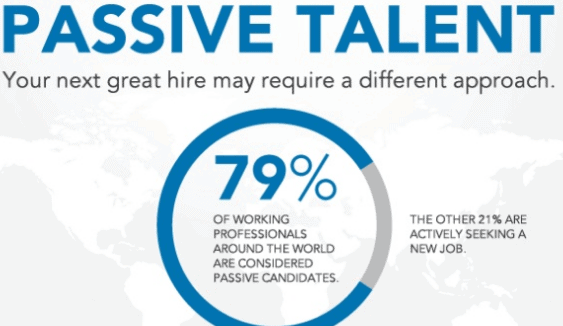
Passive candidates and why you should recruit them

It’s no secret that some industries are easier to recruit for than others.
The tech space for developers is one that continually challenges the patience of HR professionals. The perfect candidate is usually already employed as statistics indicate that almost three quarters of developers are open to a new job but only 15% are actively looking.
 But what about those candidates that are employed, but might be open to something new? Well, these make up over 79% of global working professionals.
But what about those candidates that are employed, but might be open to something new? Well, these make up over 79% of global working professionals.
Someone who is content in their current arrangement usually doesn’t submit job applications or respond to recruiter outreach. What do you do when qualified candidates are scarce and your company needs the extra hands on deck?
We are going to explain the differences between active candidates vs passive candidates and illustrate the important steps of a passive strategy in tech. Keep reading if you want to know more.

Image credit: LinkedIn
What are passive and active candidates?
A lot of people are asking, what does passive interest mean and what is a passive employee definition? Candidates with passive interest are currently employed and are not seeking out new opportunities directly but still may be open to a change.
As passive candidates are usually happy with their jobs, recruiting them requires a lot more effort. Your role as a recruiter can quickly become something that resembles more of a salesperson if you’ve identified the right person.
An active candidate is one looking for a new opportunity. They may or may not have a job, however they have been active on job boards, social media, and are the type of candidates intently sending resumes and applications. Active candidates are obviously easier to find, despite the fact they only make up less than 20% of the global workforce.
An effective recruitment strategy should encompass encouraging both passive and active candidates to apply for a role. Passive candidates are often employed for a reason and they shouldn’t be ruled out just because they’re not actively searching for a job.
In fact, they are often the most valuable type of candidate.
 Image credit: Morgan McKinley
Image credit: Morgan McKinley
Why passive candidates are so sought-after in tech
As a recruiter, you already know that passive candidates are likely to be a good fit since they were successfully performing the role at another company.
Passive candidates are usually best suited for highly-skilled positions where there’s a skills shortage. Their knowledge is sought for critical roles, where a bad hiring decision on someone more inexperienced can have dire consequences.
Another reason is that it’s rare to find a skilled developer as an active candidate. Because there are a finite number of experienced active candidates on the market, competition is intense.
Numbers that support passive candidates
If you blink, you might miss them. The very best talent is often off the market within 10 days. These discouraging numbers influence recruiters to put more emphasis on passive candidates.
According to LinkedIn, passive candidates are 120% more likely to want to make an impact on your business. On top of that, they are 17% less likely to need skill development opportunities than an active candidate.
A huge amount of options, experience in the field and the likelihood of less necessary training means passive candidates are an attractive proposition to any employer. There’s a reason almost 98% of talent teams see passive candidates as an important source of hire.
To lay it all out, ignoring passive job seekers means missing out on a big portion of high-calibre candidates.
Learn to communicate with passive candidates (and learn to let go)
In selling your employer brand to both active and passive candidates, it’s important to consider what your expected ROI (return on investment) is. How far are you willing to go for a candidate?
Keep in mind that in this situation it’s best not to put all your eggs in one basket.
If you have success touching base with passive candidates then that’s great, but if not, the line between reaching out and pestering is a thin one.
As an example, one of the biggest selling points of Stack Overflow Jobs is that “Stack Overflow Jobs puts developers first. No recruiter spam or fake job listings.”
When trying to recruit passive candidates, you need to determine how much time and money it will take in order to make a new hire. You also need to determine when it’s time to move on.
Don’t forget your ethics
Remember that it’s hypocritical for employers to prefer passive candidates unless they also assume that their own employees are open to contacts from other firms and approve of that activity.
It is unethical to engage in passive-candidate outreach while discouraging or forbidding their own employees to accept similar overtures. It’s worth following the simple rule, treat others as how you would like to be treated.

Image credit: Temp Mail
Steps to improve your passive candidate recruitment strategy
It’ll take a bit of strategy and a well-rounded approach by the entire department to encourage a passive candidate to consider leaving their job. Here are the steps we’d take to improve your passive candidate recruitment strategy.
- Company branding – 75% of professionals would not take a job with a company that had a bad reputation, even if they were unemployed. Ensure that your company’s brand is doing you favors and not a disservice. Shaping a company’s brand is done at the executive level and then amplified by the marketing department. You can share your strong brand repetitively on job boards, outreach messages, and social channels. Get employees on board so they can represent the company on their behalf.
- Superior sourcing – There are a number of ways to find passive candidates, some more effective than others.
- Use your talent pipeline – Invest in reliable ATS software so you’ve got a sustainable way of keeping track of high-quality candidates that just missed out on the last opening. Sometimes the right hire was already on your radar. In order not to miss the right talent, consider seeking help from PEO services or an employer of record that will help with the recruitment process and clarify the payment terms.
- Smash social media – Oversaturation on LinkedIn is the main reason that 52% of hiring managers claim that passive candidate recruiting could become less effective. Facebook, Twitter, and forum platforms like Hashnode are other alternatives to get in touch, share your brand and source for the perfect candidate.
- Establish a referral program – Incentivize your employees’ recommendations of talent from their networks by establishing a referral program. Be wary of recruiting exclusively within your networks though, as it can lead to excessively homogeneous workplaces.
- Industry events – Recruitment events are as popular as ever, and they’re a great way to get to build relationships quicker with potential candidates. A platform like Meetup can facilitate less official, informal meetings like these.
- Job boards and databases – Check out resume databases like Talentbin, Careerbuilder, or Hired. Portfolio websites such as Github or Carbonmade can also be useful resources.
 Image credit: Influx Recruitment
Image credit: Influx Recruitment - Build relationships – It’s important to build relationships with passive candidates when you first get in touch. Don’t give them an immediate pitch. It’s a longer-term game you’re playing, so you want to make a personal connection first. As they’re not actively looking for a new role, they might need to be “warmed up” before they’re ready for the hard sell. There’s a good reason for being patient to build the relationship and getting a better picture of their career goals and their desires. At worst you’ve expanded your network by approaching the right way.
- Develop a value proposition – Put yourself in the shoes of the candidate. Think of the kind of things that would convince you to leave a job you were happy at to join a new company. Then formulate a value proposition to sell to passive candidates and extend an offer they can’t refuse. To help make the “sale”, provide exactly what the passive candidate needs to consider a change for their career. Ensure your case is clear and direct and leave the ball in their court.
- Stay vigilant and follow up – Maintain contact with the candidate with an occasional follow-up, but remember not to spam them. Identify whether the person has shown signs of disinterest or if they are genuinely mulling it over. Know when to give up if time has passed. Even if the candidate doesn’t apply immediately, they’re at least aware the opportunity is a possibility in the future.
Final Thoughts
Active candidates certainly make a recruiter’s life easier as they do a lot of their work for them. Unfortunately, the reality is that often the best employee is already employed. Sourcing passive candidates is more of a challenge, but the process is absolutely vital in today’s competitive job market.
It couldn’t be more apparent than in tech, where the number of employed developers far outweigh those without a job. The numbers simply do not lie.
The silver lining is that passive candidates are not unicorns and there is a way to sound them out. Unbelievably, 85% of employed people are open to switching jobs!
Give a shot to the tips above and let us know how you went with your passive candidate recruiting. Also, if you want to optimize your hiring process, make sure you learn about full life cycle recruitment next!
Image credit: Danial RiCaRoS on Unsplash




